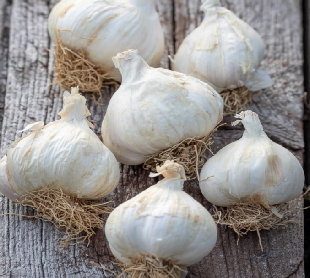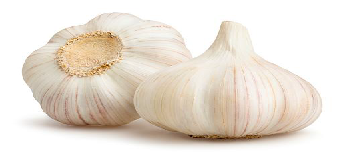







&



GARLIC -
Softneck garlic generally produces smaller, more tightly-
Does not produce flower stalks unless stressed
It is best harvested when the foliage starts going over
It has better storage qualities than hardneck varieties
If autumn planted it will keep until mid-
If planted in early spring it can be stored until next spring
GARLIC -
Hardneck garlic originates from climates with colder winters:
Flower stalks appear readily
Fewer, larger cloves covered with a looser tunic are produced
It is considered to have stronger and more interesting flavour
It is best gathered when the foliage has changed colour
It stores only until mid-
ELEPHANT
Elephant garlic is not a true garlic -
The cloves sometimes do not divide, producing just slightly larger single clove (solo) bulbs. The single-
CULTIVATION
Choose an open,sunny site and well-
Prior to planting improve the soils structure, moisture retention and nutrient levels by incorporating organic matter. On average soils, apply a balanced fertiliser such as Growmore at 25g per square metre (1 oz per square yard). Where organic matter was not applied double the amount of fertiliser.
After planting, garlic needs a cool one to two month period temperatures of 0 to 10 C for good bulb development. Planting in late autumn or early spring should provide the necessary chilling period.
Break the bulb into individual cloves. Plant about 6 inches apart in rows 12 inches apart. The tips of the cloves should be about an inch below the surface. Or a little deeper in light soils. Elephant garlic cloves need wider spacing.
If the ground is heavy and wet then it is better to start the plants off in modules for planting out when conditions are better.
As the foliage of garlic casts little shadow, the crop can be easily swamped by weeds, this would negatively affect their growth. Hand weed regularly not with a hoe.
Garlic needs water to produce a decent crop. You should water every 14 days during prolonged spells of dry weather. Stop watering when the foliage behind go yellow which indicates the onset of maturity. Overhead irrigation could encourage fungal disease. Remove any flower stalks that appear.
Harvest autumn planted garlic in early summer and the spring planted garlic from mid summer onwards. Lift the bulbs once foliage starts to fade and go yellow.
The most common problem affecting garlic (and other alliums) is rust. A bad attack can leave the crop as a copper coloured bed. There is no chemical treatment currently available. Avoid high nitrogen situations / rich soil and close planting which might reduce ventilation.
Our Stock Garlic
Elephant Garlic
Sold as individual cloves.

GARLIC
Garlic is a member of the onion family; it is a staple of the Mediterranean cooking and is simple to grow in a warm sunny climate.
The complete bulb is made up of 10 cloves and it is split into these separate pieces for the kitchen and planting.
There are two main types of garlic these being the soft neck and hard neck varieties. There is also a related crop called elephant garlic.

We have had to change our supplier so details here are uncertain. We will be obtaining a supply of Germidour and of Elephant garlic but will be ordering other varieties from Kings Seeds when asked to do so. A bit of an experiment this year.
Germidour

Position: full sun
Soil: well-
Rate of growth: average
Hardiness: fully hardy
Forming large bulbs with a mild, yet rich flavour, 'Germidour' is a popular French softneck variety that is easy to grow here in the UK. A great addition to the kitchen garden or allotment, these can also be grown in pots, which makes them ideal for courtyard gardens -